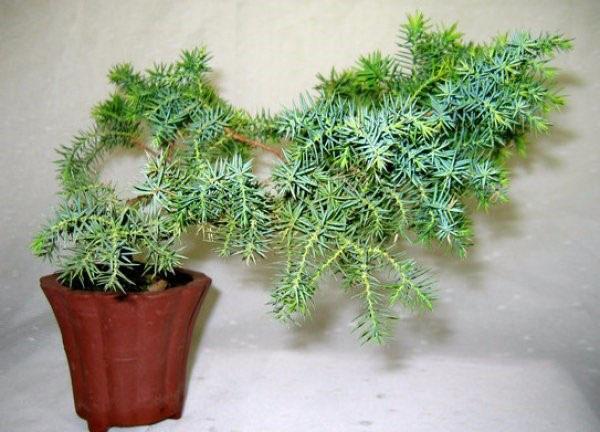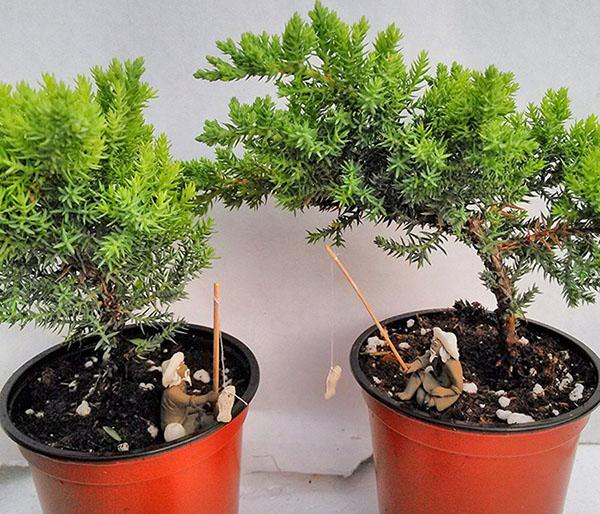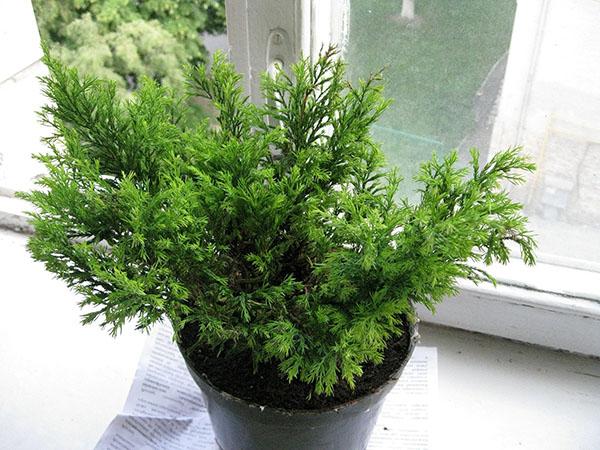How to grow a juniper at home in a pot and get joy
 What could be more pleasant than a lush evergreen that gives the interior a chic look. Many grow junipers at home in a pot and get real satisfaction. After all, a small tree fills the room with an exquisite aroma and purifies the air. In the natural environment, you can find a juniper over 10 m high. However, in indoor conditions, the plants are much lower, which makes them especially popular in our time. What is a miniature juniper that our compatriots like so much? What is the secret of growing it? How to properly care for him? The answers to these questions will help beginners start growing an exotic plant.
What could be more pleasant than a lush evergreen that gives the interior a chic look. Many grow junipers at home in a pot and get real satisfaction. After all, a small tree fills the room with an exquisite aroma and purifies the air. In the natural environment, you can find a juniper over 10 m high. However, in indoor conditions, the plants are much lower, which makes them especially popular in our time. What is a miniature juniper that our compatriots like so much? What is the secret of growing it? How to properly care for him? The answers to these questions will help beginners start growing an exotic plant.
The secret of attractiveness is a slim "figure"

Each of them has its own flavor, but all are united by a sophisticated appearance:
- miniature needles;
- cute bumps;
- pleasant resinous aroma;
- unpretentious care.
Almost all decorative home junipers are distinguished by a slender cone-shaped or ovoid crown. Among the dense needles (in its axils), miniature yellow spikelets are formed. Cones, consisting of light green scales, rise next to them. At the time of lush flowering, male spikelets pollinate female cones, after which bright blue fruits appear on the branches. A truly magnificent sight!
Not all types are suitable for growing junipers in an apartment, but only undersized varieties. The most popular ones are:
- horizontal;
- Chinese;
- ordinary;
- solid.
Many people like horizontal juniper "Wiltoni"which has blue needles. It grows very slowly, so it can decorate the interior of a living space for a long time. A suitable juniper variety for the home "Compressa" is distinguished by its exquisite pillar shape. An adult plant grows only 60 cm in height, which allows it to be placed in any corner of the room.
In its natural environment, the juniper reaches about 600 years. Indoor counterparts live much less, but this is enough to enjoy their beauty.
Juniper at home in a pot: planting secrets
 Before you start growing an evergreen crop at home, you should choose a suitable container. It must be spacious enough for the root system to develop successfully. In addition, a drainage layer will occupy some part of the pot.
Before you start growing an evergreen crop at home, you should choose a suitable container. It must be spacious enough for the root system to develop successfully. In addition, a drainage layer will occupy some part of the pot.
Containers made from natural raw materials are welcome:
- clay;
- ceramic;
- porcelain.
For a harmonious combination of the flowerpot with the interior of the room, choose a color or a beautiful pattern. The main thing is that he emphasizes the magnificence of the plant, and does not attract attention to himself.
The next step is to prepare soil for juniper in a pot from the necessary components. As a rule, the plant grows wonderfully in porous soil, as it evenly passes moisture and air to the root system.
It is prepared from traditional ingredients:
- turf land;
- peat;
- sand.
The finished mixture is fertilized with nitrophos or another suitable preparation, which is sold in shops for gardeners.
A good option for growing a juniper is a container with a pallet. In this case, watering is carried out through it.
When the soil has been prepared, we will figure out how to plant a juniper and take care of it at home. First, a funnel is made in the pot. Its depth should be 2 times the height of the plant. It is advisable to take a seedling with an earthen lump. When planting, the plant is lowered into a hole so that the root system is 8 cm above the bottom of the prepared funnel. Holding the juniper lightly, sprinkle the rhizome with earth. The top layer is tamped and sprinkled with humus or peat.
Simple ways to propagate an evergreen indoor culture
 There are 2 traditional options for growing junipers at home in a pot: using cuttings and seeds. The first method is considered quite simple. An adult plant is used as a planting material, which is at least 8 years old.
There are 2 traditional options for growing junipers at home in a pot: using cuttings and seeds. The first method is considered quite simple. An adult plant is used as a planting material, which is at least 8 years old.
Twigs are cut in the spring. Each of them should be about 10 cm. The cuttings are placed in soil consisting of sand and peat. The boxes are covered with foil and placed in a place protected from the sun. In order for the seedlings to develop successfully, they are regularly watered and sprayed with a spray bottle. After about 62 days, the seedlings will have roots. When they get stronger, they are transplanted into containers or flowerpots.
 The question of how to grow a juniper from seeds is of interest to many gardeners, since this is not an easy task. Due to the poor germination of the plant, this method is most often used by breeders. However, do not give up, some of the experiment was a success.
The question of how to grow a juniper from seeds is of interest to many gardeners, since this is not an easy task. Due to the poor germination of the plant, this method is most often used by breeders. However, do not give up, some of the experiment was a success.
The "creative process" begins with the preparation of the planting material. In late autumn, it is placed in containers with soil. Then they take it out into the street for 4 months. While in the air, the seeds undergo a special stratification... In late spring, they are sown in pots, which are placed in a room with a lot of light. The soil is watered regularly so that it does not dry out. The first seedlings will appear only after a whole year.
Basic rules for caring for culture

Sensible juniper care includes several basic procedures:
- regular watering;
- spraying the ground part of the plant;
- top dressing of the soil;
- planned pruning;
- transfer to a new container.
 Typically, this evergreen crop loves moderate moisture. In the summer heat, the procedure is carried out as the topsoil dries out. Enough once for 2 days. In winter, the plant is watered 2 times a month. Regardless of where the juniper is located: in the shade or in the sun, it needs regular spraying. In summer, moistening is done at least 2 times a day, and in winter as needed.
Typically, this evergreen crop loves moderate moisture. In the summer heat, the procedure is carried out as the topsoil dries out. Enough once for 2 days. In winter, the plant is watered 2 times a month. Regardless of where the juniper is located: in the shade or in the sun, it needs regular spraying. In summer, moistening is done at least 2 times a day, and in winter as needed.
The main task of the gardener is to prevent the potting substrate from drying out.
Plant feeding is carried out during its active development. This usually happens from April to September. Prepare a solution in the traditional way, diluting fertilizers in clean water. The proportions are usually indicated on the packaging of the drug. Approximately 1 part of fertilizer is 5 parts of water. Regardless of age, indoor juniper is fed with an interval of 14 days. The main reason is a closed room, which limits the intake of nutrients in a natural way. Top dressing is stopped at the end of autumn, preparing the culture for the winter period.
 Since central heating can be detrimental to crop growth, it is important to find a suitable location for it. A good option is to place the juniper in the winter on the balcony, which is reliably protected from frost. If necessary, the flowerpots are insulated with plastic wrap. At the end of winter, they start pruning to create a beautiful shape for the culture. Sometimes it's just a cone, but adventurous gardeners can come up with other options. In addition, the juniper growing on the balcony is transplanted into new larger pots. The procedure is performed in early spring, around mid-March.The optimum plant height does not exceed 100 cm.
Since central heating can be detrimental to crop growth, it is important to find a suitable location for it. A good option is to place the juniper in the winter on the balcony, which is reliably protected from frost. If necessary, the flowerpots are insulated with plastic wrap. At the end of winter, they start pruning to create a beautiful shape for the culture. Sometimes it's just a cone, but adventurous gardeners can come up with other options. In addition, the juniper growing on the balcony is transplanted into new larger pots. The procedure is performed in early spring, around mid-March.The optimum plant height does not exceed 100 cm.
Having become acquainted with an evergreen plant, you will probably want to grow it in your home. To do this, you should follow just a few simple rules for planting a plant. Carefully look after and find a worthy place for him in the living space. Let the luscious greenery and resinous aroma of juniper at home in a pot always bring joy to true fans of exotic indoor plants.